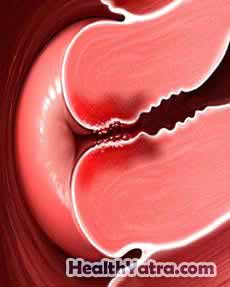Definition
The cervix is the lower portion of the uterus (womb) that is located at the top of the vagina. Cervical cryosurgery is the use of extreme cold to freeze areas of the cervix.
Reasons for Procedure
This procedure is done to destroy and remove abnormal cells of the cervix, particularly precancerous cells.

Possible Complications
Complications are rare. But, no procedure is completely free of risk. If you are planning to have this procedure, your doctor will review a list of possible complications. These may include:
- Dizziness, fainting, hot flashes (during or right after the procedure)
- Cramping (during the procedure)
- Bleeding
- Infection
- Scarring or narrowing of the cervical opening
Factors that may put you at risk for complications during this procedure include:
- Smoking
- Undiagnosed infection
- Bleeding disorder
- Diabetes
- Obesity
What to Expect
Prior to Procedure
You may want to plan for someone to drive you home.
Normally, no medicines are needed for this procedure. However, pain medicines such as ibuprofen (eg, Advil), naproxen (eg, Aleve), or acetaminophen (eg, Tylenol) are usually taken. They should be taken about an hour before your appointment. Ask your doctor if this is recommended for you.
Description of Procedure
You will lie on an exam table with your feet in foot rests, as you would for a pelvic exam. A device called a speculum is inserted into the vagina to hold it open. The cryosurgery probe is inserted into the vagina. Nitrous oxide makes the tip extremely cold. The tip is touched to abnormal areas on the cervix. It is held there for a few minutes. You may feel some cramping. The tip is removed. This allows the tissue to return to its normal temperature over the course of 3-5 minutes. This freezing and thawing cycle may be repeated several times for each abnormal area on the cervix.
You will remain lying down for at least ten minutes after the procedure. Some women may feel dizzy and/or flushed after the procedure.
How Long Will It Take?
10-20 minutes
Will It Hurt?
You will probably feel some cramping during the procedure. Some women also describe a burning sensation.
Post-procedure Care
At Home
When you return home after the procedure, do the following to help ensure a smooth recovery:
- Follow your doctor’s instructions .
- Wear a sanitary pad to absorb the watery discharge that normally occurs for several weeks following cryosurgery.
- If needed, take acetaminophen or ibuprofen to treat discomfort for a day or two after the procedure.
- Do not use tampons. Ask your doctor when you can resume sexual relations.
- Your doctor will schedule regular pap smears in the near future.
- Baths and showers are OK.
The abnormal tissue of the cervix should shed and flow out of the body in a watery vaginal discharge over 4-6 weeks. In some cases, more than one cryosurgery session may be scheduled.
Call Your Doctor
After arriving home, contact your doctor if any of the following occurs:
- Signs of infection, including fever and chills
- Abdominal pain
- Vaginal bleeding other than light spotting, especially if it soaks more than one pad per hour
- Any foul-smelling vaginal discharge
- Continued pain or cramping not relieved by over-the-counter pain medicines
In case of an emergency, call for medical help right away.
